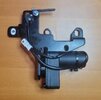johnnyruz
Member
So I’m was also a bit scared myself but I went ahead with the installation anyway this afternoon for a few reasons.
I have the Tlyard version of the mechanism which has the motor integrated with the body of the mechanism. You connect the small cable from the motor to the factory switch and when activated it pulls the latch pulls down to engage.
I did some bench-testing and the operation is that when engaged, the motor spins until it hits a stop and then reverses the tension. I think the control box is just sensing the spike in current from the motor when it hits the end of travel on the “pull” stroke and then initiates the reverse action. This is where I was getting spooked because based on the failure description from @ngng it sounds like at some point his unit triggered the “pull” signal but hit the end of travel and never sent the “retract” signal which I’m guessing pulled too much current and blew the fuse, so the unit was dead with the cable fully tensioned. I simulated this failure on the bench by turning off power at the bottom of the cycle and it definitely locked up with the cable under tension. However, even in this state I was able to manually pull the cable and rotate the motor to the “released” position with minimal force. So I think in the event of a similar failure, the force of the factory spring release mechanism when unlatching is enough to pull the motor in the reverse direction and release its hold. Or I would maybe need to put just a bit of force when opening it the frunk to retract the pull cable.
If I get some time I may actually try to test this in the car by manually initiating a close but then disconnect power at the bottom of the pull stroke. Then pop the frunk and see if the factory latch still releases.
If that’s the case, the only way I could see my version locking up would be if the motor got stuck permanently receiving the pull signal but the controller did not successfully release, but in that case I would think it would result in a blown inline fuse killing power to the motor and allowing the frunk to open normally. I’ll update if I get a chance to perform this test.
On the install, it went very smooth and is working extremely well. I skipped the install of the “patch” as I’m still not sure of its purpose. But if anyone here knows for sure it’s a great idea to install it I’ll go back and put it in.
Also, I put some heat-shrink tubing on the “arm” of the soft close just so there is no metal-to-metal contact as the hood latches.
I have the Tlyard version of the mechanism which has the motor integrated with the body of the mechanism. You connect the small cable from the motor to the factory switch and when activated it pulls the latch pulls down to engage.
I did some bench-testing and the operation is that when engaged, the motor spins until it hits a stop and then reverses the tension. I think the control box is just sensing the spike in current from the motor when it hits the end of travel on the “pull” stroke and then initiates the reverse action. This is where I was getting spooked because based on the failure description from @ngng it sounds like at some point his unit triggered the “pull” signal but hit the end of travel and never sent the “retract” signal which I’m guessing pulled too much current and blew the fuse, so the unit was dead with the cable fully tensioned. I simulated this failure on the bench by turning off power at the bottom of the cycle and it definitely locked up with the cable under tension. However, even in this state I was able to manually pull the cable and rotate the motor to the “released” position with minimal force. So I think in the event of a similar failure, the force of the factory spring release mechanism when unlatching is enough to pull the motor in the reverse direction and release its hold. Or I would maybe need to put just a bit of force when opening it the frunk to retract the pull cable.
If I get some time I may actually try to test this in the car by manually initiating a close but then disconnect power at the bottom of the pull stroke. Then pop the frunk and see if the factory latch still releases.
If that’s the case, the only way I could see my version locking up would be if the motor got stuck permanently receiving the pull signal but the controller did not successfully release, but in that case I would think it would result in a blown inline fuse killing power to the motor and allowing the frunk to open normally. I’ll update if I get a chance to perform this test.
On the install, it went very smooth and is working extremely well. I skipped the install of the “patch” as I’m still not sure of its purpose. But if anyone here knows for sure it’s a great idea to install it I’ll go back and put it in.
Also, I put some heat-shrink tubing on the “arm” of the soft close just so there is no metal-to-metal contact as the hood latches.




